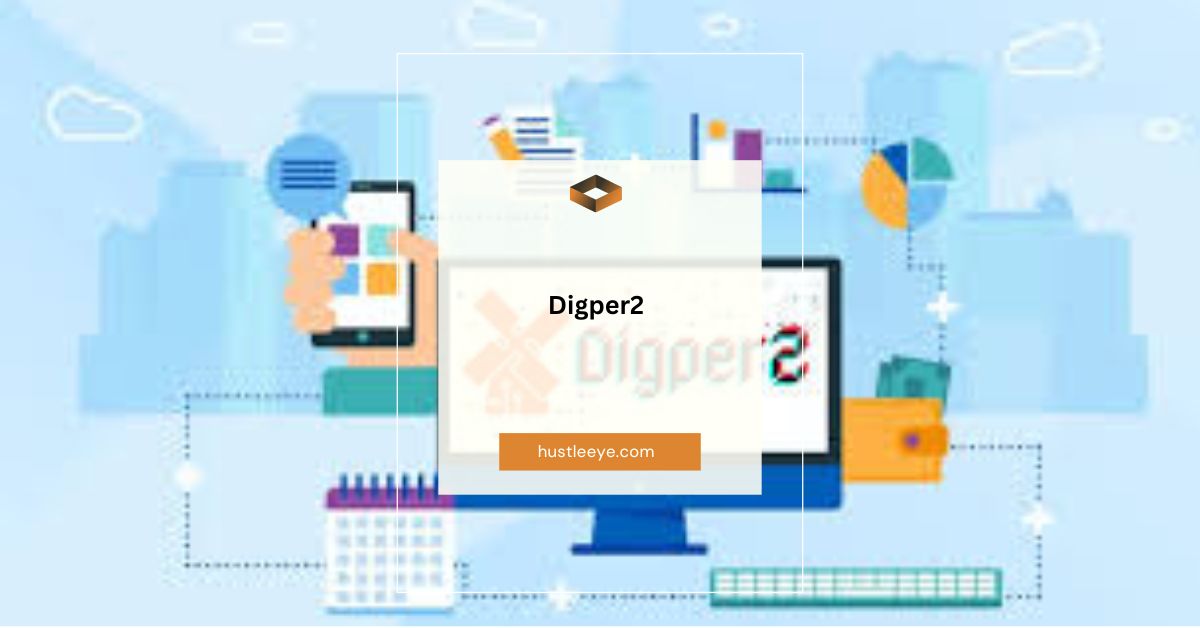The world is evolving at a rapid pace, driven by technological advancements that are reshaping industries across the globe. One of the most promising developments in this digital revolution is Digper2, short for “Digital Performance 2.0.” This next-generation digital transformation framework is designed to leverage cutting-edge technologies like artificial intelligence (AI), machine learning (ML), big data analytics, and the Internet of Things (IoT) to optimize business operations and enhance customer experiences.
In this article, we’ll dive deep into Digper2, exploring its core components, applications across industries, benefits, challenges, and its potential to shape the future of digital transformation. Our aim is to provide you with a comprehensive understanding of Digper2, ensuring that you’re well-equipped to navigate this new digital frontier.
Table of Contents
What is Digper2?
Digper2 is an advanced digital transformation concept that focuses on improving operational efficiency, decision-making, and customer engagement through the integration of modern technologies. This platform utilizes AI, ML, big data, IoT, and cloud computing to create intelligent, data-driven solutions that can help organizations in a variety of industries reach their full potential.
1. Key Elements of Digper2:
- Artificial Intelligence (AI) and Machine Learning (ML)
These technologies form the backbone of Digper2, enabling businesses to automate processes, enhance data analysis, and predict future trends. AI and ML allow for smarter decision-making by processing massive datasets and providing real-time insights that help drive performance improvements. - Big Data Analytics
Digper2 uses big data to analyze and interpret vast quantities of information, offering valuable insights into customer behavior, market trends, and internal operations. This data-driven approach supports informed decision-making and ensures that organizations can stay ahead of the competition. - Internet of Things (IoT)
IoT connects devices and systems, allowing for seamless data exchange in real-time. In Digper2, IoT plays a crucial role in optimizing operational efficiency and enabling proactive maintenance by delivering critical data to businesses instantly. - Cloud Computing
The scalability of cloud computing provides businesses with the flexibility to grow and adapt quickly. Digper2’s cloud-based solutions ensure that organizations can deploy and manage new technologies efficiently, without heavy infrastructure investments.
Read More: Howard A. Fetner DMD News: A Comprehensive Overview
Applications of Digper2 Across Industries:
The versatility of Digper2 makes it applicable to a wide range of sectors, each of which can benefit from its advanced digital solutions.
1. Healthcare:
The healthcare industry is rapidly adopting Digper2 to improve patient outcomes and streamline operations. AI and ML analyze vast amounts of patient data, enabling more accurate diagnostics and personalized treatment plans. IoT devices, such as wearable health monitors, collect real-time patient data, allowing healthcare providers to intervene when necessary and ensure timely medical care.
Key Benefits in Healthcare:
- Enhanced patient monitoring through IoT
- AI-powered predictive analytics for improved diagnostics
- Personalized patient care based on big data insights
2. Retail:
Digper2 is transforming the retail sector by enabling personalized shopping experiences and optimizing inventory management. Retailers can use AI to analyze consumer behavior, providing personalized product recommendations and targeted marketing campaigns. IoT-enabled sensors help retailers manage inventory in real-time, ensuring that popular products are always in stock.
Key Benefits in Retail:
- Improved customer engagement through personalized shopping experiences
- Real-time inventory management with IoT
- Data-driven marketing strategies using big data
3. Manufacturing:
Manufacturing industries benefit greatly from Digper2’s ability to streamline production processes and ensure consistent product quality. IoT sensors monitor machinery and equipment, identifying maintenance needs before they cause disruptions. Advanced analytics optimize supply chain operations, reducing costs and improving overall efficiency.
Key Benefits in Manufacturing:
- Reduced downtime through predictive maintenance
- Optimized supply chain management with big data analytics
- Enhanced production efficiency with AI automation
4. Finance:
The finance industry relies heavily on data and risk management, making it an ideal sector for Digper2 applications. AI and ML algorithms can detect fraudulent activities by analyzing transaction patterns, while big data insights help financial institutions make better investment decisions. Additionally, Digper2 enhances customer service by providing personalized financial advice and automating routine tasks.
Key Benefits in Finance:
- Enhanced fraud detection using AI
- Improved risk management with predictive analytics
- Personalized financial services through big data
Read More: Coded Warlock Notes: Unraveling the Mysteries of World of Warcraft
Benefits of Digper2: Transforming Digital Performance:
The adoption of Digper2 offers numerous benefits that help organizations improve their digital performance and adapt to a rapidly changing technological landscape.
1. Enhanced Decision-Making:
With big data analytics and AI at the core of Digper2, businesses gain access to powerful tools that help them make informed, data-driven decisions. Predictive analytics allows organizations to anticipate future trends, helping them stay ahead of competitors and minimize risks.
2. Operational Efficiency:
Automation through AI and IoT integration reduces manual interventions, streamlines operations, and eliminates errors. Real-time data monitoring ensures optimal resource utilization, leading to higher productivity and reduced costs.
3. Improved Customer Experience:
Personalization is a key feature of Digper2, allowing businesses to tailor their products and services to individual customer preferences. AI-powered chatbots and virtual assistants provide instant customer support, while personalized recommendations improve overall engagement and satisfaction.
4. Innovation and Agility:
Digper2 enables businesses to rapidly experiment with and deploy new digital solutions. Cloud computing provides the scalability needed to quickly adjust to changing market demands, while AI-driven insights support continuous innovation.
Read More: Pimantle: The Ultimate Guide to the Advanced Semantic Word Game
Challenges and Considerations for Implementing Digper2:
While Digper2 offers tremendous benefits, organizations must also be aware of the challenges they may face when implementing this digital framework.
1. Data Privacy and Security:
With the extensive use of data in Digper2, there are concerns about privacy and security. Organizations must implement stringent data protection protocols to ensure compliance with regulations and protect sensitive information from cyber threats.
2. Skill Gaps:
The implementation of Digper2 technologies requires a skilled workforce. Organizations must invest in upskilling their employees and ensure that they have access to professionals who can develop, deploy, and manage these advanced solutions.
3. Integration Complexity:
Integrating Digper2 with existing legacy systems can be a complex and time-consuming process. A phased approach to implementation is often necessary to minimize disruptions and ensure a seamless transition.
4. Cost Implications:
Adopting Digper2 requires significant investment in infrastructure, tools, and talent. Organizations need to carefully evaluate the costs associated with the integration of Digper2 technologies and ensure that they can achieve a strong return on investment.
Read More: MedNetwerk: Revolutionizing Healthcare Communication
The Future of Digper2: Emerging Trends and Innovations
The future of Digper2 is full of promise, with several emerging technologies set to further enhance its capabilities.
1. 5G and Edge Computing:
The advent of 5G technology will revolutionize Digper2 by providing faster and more reliable connectivity. Edge computing, which involves processing data closer to the source, will complement 5G by reducing latency and improving the efficiency of IoT applications.
2. Blockchain Technology:
Blockchain is expected to play a crucial role in Digper2, enhancing data security and enabling transparent, decentralized digital transactions. Blockchain’s ability to ensure the integrity of data makes it an ideal complement to the AI and IoT technologies used in Digper2.
3. Ethical AI:
As AI becomes more pervasive, ethical considerations will become increasingly important. Ensuring that AI algorithms are transparent, fair, and free from bias will be crucial to building trust and ensuring responsible AI deployment.
4. Sustainability:
Sustainability will continue to be a focus for organizations using Digper2. By optimizing resource utilization and reducing waste, Digper2 technologies can help businesses adopt more environmentally friendly practices and contribute to global sustainability efforts.
Read More: The Extraordinary Journey of Basil Fomanka: A Comprehensive Insight
FAQs About Digper2:
1. What is Digper2?
Digper2, short for “Digital Performance 2.0,” is a digital transformation framework that leverages advanced technologies like AI, ML, IoT, and big data to improve operational efficiency and enhance customer experiences across industries.
2. How does Digper2 work?
Digper2 works by integrating technologies such as artificial intelligence, machine learning, and IoT to automate processes, analyze data in real-time, and optimize business operations. It provides valuable insights that help organizations make informed decisions and innovate quickly.
3. What industries can benefit from Digper2?
Digper2 is highly versatile and can be applied to a wide range of industries, including healthcare, retail, manufacturing, finance, and more. Its ability to improve efficiency, decision-making, and customer engagement makes it valuable for almost any sector.
4. What are the main challenges in adopting Digper2?
The main challenges include data privacy and security concerns, skill gaps, the complexity of integrating with legacy systems, and the cost of implementing these advanced technologies.
5. What is the future of Digper2?
The future of Digper2 will be shaped by emerging technologies like 5G, edge computing, and blockchain. Additionally, ethical AI and sustainability practices will become increasingly important as Digper2 continues to evolve.
Conclusion:
Digper2 is revolutionizing digital performance across industries by harnessing the power of advanced technologies like AI, ML, IoT, and big data analytics. Its ability to enhance operational efficiency, improve decision-making, and provide personalized customer experiences makes it a critical tool for businesses looking to thrive in today’s digital world.
However, the journey toward adopting Digper2 comes with its challenges—particularly around data security, skill requirements, and integration costs. By carefully planning and addressing these concerns, organizations can unlock the full potential of Digper2 and position themselves for success in the future.
With emerging technologies like 5G, blockchain, and ethical AI on the horizon, the future of Digper2 looks brighter than ever. It is poised to lead the way in shaping a smarter, more connected, and sustainable digital landscape.


